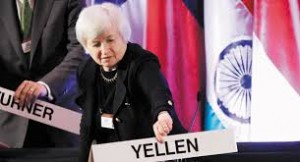While the week’s biggest news has taken place in Russia, Ukraine and China, it’s the news out of the Federal Reserve Board’s Federal Open Market Committee that’s most in need of translation.
The Fed regularly uses language that no one understands, because if America’s taxpayers really knew what’s been happening, they’d totally freak. Keep that in mind and proceed with caution as we attempt a translation of Fedspeak from new Chair Janet Yellen’s first press conference:
“ … the FOMC’s outlook for continued progress toward our goals of maximum employment and inflation returning to two percent remains broadly unchanged.”
The dots are moving and we’re not achieving the results we expected, but you won’t hear it from me. 
“Unusually harsh weather in January and February has made assessing the underlying strength of the economy especially challenging.”
The economy still stinks, but we’re going to blame it on the weather.
The unemployment rate, at 6.7 percent, is three‐tenths lower than the data available at the time of the December meeting. Further, broader measures of unemployment such as the U6 measure, which includes marginally attached workers and those working part‐time, but preferring full‐time work, have fallen even more than the headline unemployment rate over this period. And labor force participation has ticked up.
We still have a record number of Americans out of work, but fortunately they are taking part-time jobs or no longer looking for work, so it’s bringing the unemployment rate down. It’s a good thing they can get SNAP benefits and free health insurance through Obamacare.
The FOMC continues to see sufficient underlying strength in the economy to support ongoing improvement in the labor market.
Quantitative easing doesn’t create jobs, but fortunately employers have to add to their payrolls at some point.
Inflation has continued to run below the committee’s two percent objective.
We’ve added so much money to the economy, we should have hyperinflation by now. At least we’ve helped prevent deflation, not that anyone cared too much about prices going down.
… policy actions tend to exert pressure on inflation that is manifest only gradually over time.
QE didn’t boost inflation, as we expected, but inflation has to go up eventually and, when it does, we’ll take credit for it.
The central tendency of the unemployment rate projections has shifted down by about two tenths of a percent since December, and now stands at between 6.1 percent and 6.3 percent at the end of this year.
The unemployment rate is projected to reach it’s longer‐run normal level by the end of 2016. The central tendency of the projections for real GDP growth stands at 2.8 percent to 3 percent for 2014, and remains somewhat above that of the estimates of longer‐run normal growth through 2016.
Remember when the unemployment rate was 4.4 percent? Remember when GDP was growing at a rate of more than 7 percent a year? Neither does anyone else. And we didn’t even have quantitative easing back then.
Starting next month, we will be purchasing $55 billion of securities per month, down $10 billion per month from our current rate.
Even after today’s action takes effect, we will continue to significantly expand our holdings of longer-term securities and we will also continue to roll over maturing treasury securities and reinvest principal payments from the FOMC’s holdings of agency debt and agency mortgage‐backed securities.
These sizable and still increasing holdings will continue to put downward pressure on longer‐term interest rates, support mortgage markets, and make financial conditions more accommodative, helping to support job creation and a return of inflation to the committee’s objective.
Big banks have made a bundle, thanks to Fed policy. Sooner or later they’re going to have to start lending out some of that money. I hope to God that low interest rates hold or my term as chair is going to be a short one.
… progress in the labor market has been more rapid than we had anticipated, while inflation has been lower than the committee had expected.
Five years and $4 trillion in bond buying just to bring the unemployment rate down to 6.5 percent? Really? Even with the Bureau of Labor Statistics fudging the numbers? The inflation rate has barely budged, but tell that to Americans on fixed incomes who can barely afford food and energy prices today. So why do we want higher inflation?
… the committee will take a balanced approach to attaining its objectives.
We reserve the right to change our mind. Plus, we want investors to think that we’re going to keep buying bonds forever, so the stock market doesn’t tank.
… even after employment and inflation are near mandate consistent levels, economic conditions may for some time, warrant keeping short term interest rates below levels the committee views as normal in the longer run.
You may have noticed that I haven’t mentioned the housing market. No one can get a mortgage, thanks to Dodd-Frank, but we’ll keep interest rates low in the hope that eventually the market will recover.
… many cite the residual impacts of the financial crisis and some note that the potential growth rate of the economy may be lower at least for a time.
It’s all George Bush’s fault.
